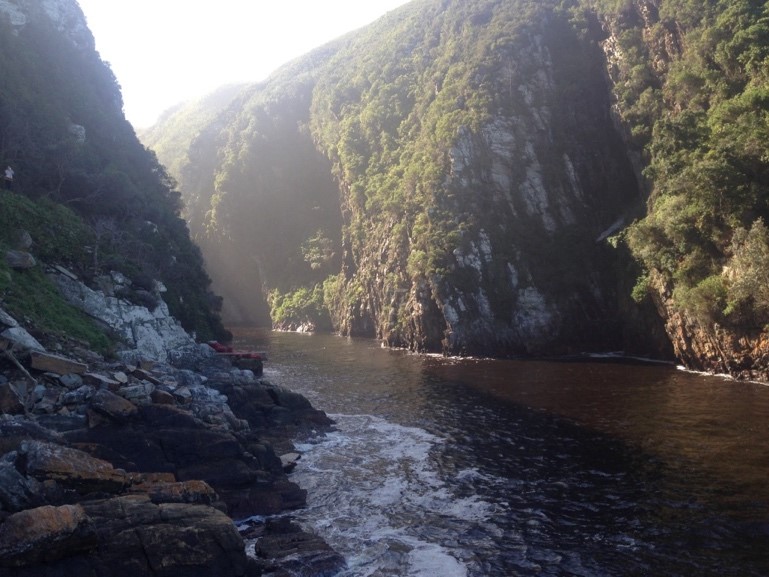
17 Nov Tsitsikamma, South Africa
Ella-Kari Muhl
Key messages
- The Tsitsikamma area includes local communities whose food security and livelihoods have been impacted negatively by various government actions, notably a no-take marine protected area (MPA).
- While MPAs are promoted as a long-term conservation strategy, no-take MPAs threaten the food security and cultural practices of fishers in areas of low economic opportunity and limited alternative livelihoods or transitional support.
- A lack of communication between the regulating authority (SANParks) and the fishers has increased conflict in the Tsitsikamma area and endangered community members’ food security and livelihoods.
- Participatory monitoring, with formalised consultation with community members, may reduce conflict and strengthen conservation goals.
Community profile
Tsitsikamma, or ‘place of much water’ in Khoisan (the local Indigenous language), is an area interlinking the Western and Eastern Cape Provinces of South Africa. The Tsitsikamma Marine Protected Area (MPA) spans 80 km and affects the food security, cultural practices and livelihoods of eight communities, including Thornham, Stormsrivier, Nompumelelo and Sanddrif (Figure 1). The Tsitsikamma National Park (TNP) MPA was created in 1964, following the 1962 IUCN World Parks Congress. The TNP MPA is the oldest in South Africa.
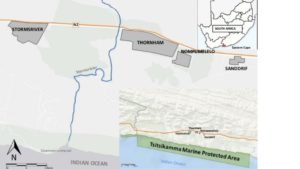
Figure 1: The location of the TNP MPA relevant to the local communities
At first, fishing was permitted in certain areas of the Tsitsikamma MPA, with a permit. This was later restricted in 1976 to only one area, before ultimately becoming a “no-take” MPA in 2000. Since this year, local fishers have been barred from harvesting marine resources despite historically having had access to the ocean and coastal resources. The communities have been reliant on mixed livelihoods, including fishing, for generations. There are currently 5,434 people residing in the four communities who, due to low economic opportunity, are reliant on fishing for food security and consider it part of their cultural practice.
Conservation and livelihood challenges
Historically, the South African government enforced racially exclusionary rules for accessing the coast and its resources, leading to the marginalisation of rural coastal communities (especially in the Eastern Cape and KwaZulu-Natal), which were dependent on coastal resources for their food security and livelihoods(2,11). In the wake of apartheid, South Africa’s National Parks have come under increased pressure to reconcile the wealth of natural resources to the social and economic needs of the previously oppressed black rural communities(1).
The impacts of “no-take” MPA
With the abolition of apartheid and introduction of democracy, it was hoped that the right of small-scale and subsistence fishers would be restored in accordance with their culture and tradition(10). When the legislative change to a “no take” MPA took place in 2000 under the Marine Living Resource Act 18 of 1998, it was shown to affect not only food security for the fishers and their families but also their cultural identity and heritage (7). The Thornham, Stormsrivier, Nompumelelo and Sanddrif communities have been reliant on fishing as a form of food security. With the loss of access to fish, there has been a reported decline in health and increase in crime(4).
Fishers stated that, in addition, their well-being has been affected by the closure of the MPA, as fishing is part of their identity(1). The current top-down governmental conservation programme, which introduced a no-take MPA as a form of conservation to promote sustainability and biodiversity, was implemented without consultation with the community, and subsequently has elevated conflict between community members and the regulating authority.
Food security, customary rights and livelihood impacts
With no alternative livelihood provided, local village economies remain limited with few economic opportunities available (Figure 2). Local household economies are poor and under severe stress.
In 2016, for example, only 52.6% of households met the financial requirements for food security, which increases fisher’s dependence on marine resources as a supplementary food source. The Reconstruction and Development Programme (RDP) housing built by the South African government in 2001 to create Nompumelelo village added 480 households to the area, placing additional pressure on resources(6). The timing of the completion of RDP housing coincided with the delineation of a no-take MPA, thus increased competition for work, and placed strain on local amenities, with already limited public services and health care.
The change in coastal access and legislation has had a negative effect on the community with a loss of livelihoods, fishing and recreational activity. The community describe themselves as being “born on the rocks (coast)”, claiming original ancestry from the indigenous Khoi-san people, indicating a consideration of the coast as a part of their culture and traditions(1,6).
Many residents in Tsitsikamma have also historically relied on coastal forests for a range of amenities, such as medicinal plants, honey and woods for fuels and building materials, which they are also denied access to.

Figure 2: A former fisher, no longer allowed to access the coast, writes poetry about the sea now.
The lack of recognition as stakeholders and exclusion from the coastline has illustrated that unless social and ecological factors are considered with the design of the MPA, illegal fishing and conflict will continue between SANParks (South African National Parks) and the local communities.
Community initiatives
In 1994, the community created the Tsitsikamma Angling Forum (TAF) to represent local fishers who wanted access to the coast. The TAF have formally petitioned against the TNP in 1976, 1995, 2006, and 2015. They have also worked with a task team comprised of the Kou Kamma municipality and SANParks to reopen the TNP in 2006, 2014 and 2015. The TAF actively protested SANParks in 2007, when 70 members fished illegally in the Tsitsikamma MPA.
Over time, the community has become increasingly mobilized and in 2015, following workshops between the Department of Environmental Affairs (DEA), Oceans and Coasts Branch, the Department of Agriculture, Forestry and Fisheries (DAFF), SANParks, the local municipality (Kou Kamma) and representatives from TAF, a decision was made to open specific areas within the MPA for fishing with restrictions. The plan to reopen certain areas was approved in December 2015 through promulgation of a government gazette but was then blocked by the Friends of the Tsitsikamma, an association that obtained a court interdict against SANParks, DEA and TAF in January 2016(9).
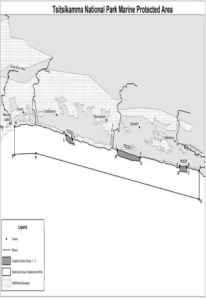
Figure 3: Map depicting the three coastal control zones within the Tsitsikamma MPA
Legal recognition of historically disadvantaged residents
Following the closure in January 2016, the TNP MPA was rezoned later in December 2016 in the new government gazette 40511(8) to allow three controlled fishing areas to be opened (Figure 3). However, the MPA re-opening process has been questioned as consultation was not carried out with local community members and was poorly conceptualized with little practical changes for community member’s food security or livelihoods.
At present, community members are required to purchase a permit. However, older fishers and minors are either prohibited or unable to fish under the new gazette ruling, halting the multi-generational transfer of knowledge. This prevents the oral traditions and teachings of the older generation from passing down to the present. The subsequent absence of SANParks at the controlled zones prevents fishers from communicating effectively with rangers and leads to miscommunication and further resentment towards SANParks.
The challenges and lack of capacity within SANParks reveal the vulnerability of the Tsitsikamma fishing communities and the need to incorporate local ecological knowledge (LEK) and community members into partnerships with researchers and authorities to better manage MPAs.
Practical outcomes
The Tsitsikamma community have issues of food security and a lack of economic opportunities or alternative livelihoods (Figure 4). The creation of the no-take MPA has disrupted a reliance on fish as a contribution to food and cultural practices(1,5).
The community members have identified five solutions that would be the most beneficial towards restoring trust between community fishers and SANParks (Figure 5).
(1) Collaboration
Community members and government officials need to work together through a duty of care and environmental stewardship for the Tsitsikamma MPA, along with an understanding that fishers would protect the resource, as long as their cultural rights were preserved and they are allowed access to harvest medicinal plants, fish and other forest items sustainably.
(2) Transgenerational access to the Tsitsikamma MPA
Emphasis is placed on elders and minors being able to access the coast for fishing and cultural practices. The older generation hold the knowledge and cultural practices from their ancestors – they are instrumental in teaching the youth the importance of using natural resources sustainably and teaching them about the species of fish, the types of medicinal plants and how to harvest them in an environmentally friendly manner.
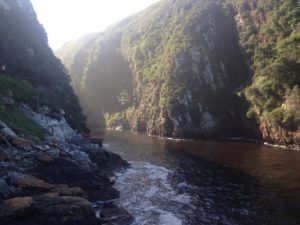
Figure 4: The Stormsrivier mouth which is located centrally in the park and would be accessible to fishers, however is reserved for tourists.
(3) Education
The fishers expressed interest in environmental education workshops for both adults and children, as almost a whole generation has not had access to the sea resulting in loss of knowledge. Fishers listed workshops as being beneficial so that they could better understand why certain species were not allowed to be caught. This would also help to clarify rules as, at present, the new government gazette is unclear and some fishers are unsure of why certain rules are in place.
(4) Communication
To empower fishers and effectively promote collaboration, communication is necessary between relevant government departments, SANParks, and working groups made up of interested parties, scientists and elected community members. Increasing the capacity of and empowering local fishers to participate in decision-making processes leads to practical, real solutions that strengthen ownership and promote care of the resource.
(5) Acknowledgement of customary rights and access rights
In order to improve management, increased understanding of government officials of the fishers’ customary rights and importance of access will foster respect and promote conservation, as well as help reduce tensions and conflict between the two parties.
Future concerns
Dialogue between the community and the regulating authorities is improving; however, for there to be a successful conservation impact, policy makers need to widely consult on proposed changes before implementing them. Top-down processes of government control only serve to further marginalise the community and promote resentment. A working partnership is necessary to establish trust and understanding with an emphasis on local ecological knowledge combined with scientific expertise for better policy and practice.
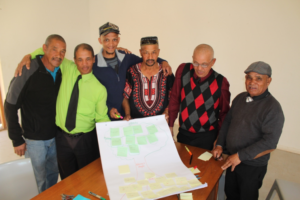
Figure 5: The Thornham Focus Group members with their list of practical outcomes
References
- Faasen, H. (2006). ‘Synergies between biodiversity conservation and sustainable rural development of adjacent communities: a case study of the Tsitsikamma National Park’. Master’s thesis (Conservation Ecology and Entomology). University of Stellenbosch, Stellenbosch, South Africa. Available at: https://scholar.sun.ac.za/handle/10019.1/2913
- Glavovic, B.C., Boonzaier, S. (2007). Confronting coastal poverty: Building sustainable coastal livelihoods in South Africa. Ocean & Coastal Management 50(1–2), pp.1–23. Available at: https://doi.org/10.1016/j. ocecoaman.2006.07.001
- Maharajh, R. J. (2003). ‘Values and concerns in decision- making about a waste reduction incinerator at Stormsriver, Tsitsikamma: A case study in applied ethics’. Master’s thesis (Philosophy). University of Stellenbosch, Stellenbosch, South Africa.
- Muhl, E.-K. (2016). ‘Food security and livelihood threats: an investigation into the lives of the fishers bordering the Tsitsikamma National Park’. Honours thesis (unpublished). University of Cape Town, South Africa.
- Muhl, E.K. (2019). ‘An analysis of the Perceptions Surrounding the re-Zoning of the Tsitsikamma Marine Protected Area’. Master’s thesis (Environmental and Geographical Science). Faculty of Science, Department of Environmental and Geographical Science, University of Cape Town, South Africa. Available at: https://open.uct.ac.za/handle/11427/31347
- Muhl, E.-K., Esteves Dias, A.C. and Armitage, D. (2020). ‘Experiences With Governance in Three Marine Conservation Zoning Initiatives: Parameters for Assessment and Pathways Forward’. Frontiers in Marine Science 7: 629. Available at: https://doi.org/10.3389/fmars.2020.00629
- Muhl, E.K. and Sowman, M., 2020. Rights, Resources, Rezoning and the Challenges of Governance in South Africa’s Oldest Marine Protected Area. Conservation and Society 18(4): 366. Available at: https://doi.org/10.4103/ cs.cs_19_154
- Republic of South Africa (2016). ‘Protected Areas Act, 2003, Act No. 57. Regulations for the Management of the Tsitsikamma National Park Marine Protected Area’. Government Gazette, Vol. 618, No. 40511, Regulation No. 10676, 19 December 2016. Pretoria. South Africa: Government Printing Works. Available at: https://www. environment.gov.za/sites/default/files/legislations/ protectedareasact57of2003%29_regulations_ sitsikammanationalpark_gg40511_0.pdf
- Republic of South Africa Department of Environment, Forestry & Fisheries (RSA DEFF) (2016). ‘Settlement reached in court on the pilot recreational angling project in the Tsitsikamma Marine Protected Area’. RSA DEFF [website]. Available at: https://www.environment.gov.za/mediarelease/courtsettlement_tsitsikammamarineprotectedarea; https://www.environment.gov.za/sites/default/files/docs/ courtjudment_ontsitsikammamarineprotectedarea2016.pdf
- Sowman, M., Scott, D., Green, L.J.F., Hara, M.M., Hauck, M., Kirsten, K., Paterson, B., Raemaekers, S., Jones, K., Sunde, J. and Turpie, J.K. (2013). ‘Shallow waters: social science research in South Africa’s marine environment’. African Journal of Marine Science 35(3): 385–402. Available at: http:// dx.doi.org/10.2989/1814232X.2013.836134
- Sunde, J. (2014). Customary governance and expressions of living customary law at Dwesa-Cwebe: contributions to small- scale fisheries governance in South Africa. Doctoral thesis (Environmental and Geographical Science). Department of Environmental and Geographical Science, University of Cape Town, South Africa. Available at: https://open.uct.ac.za/ handle/11427/13275
Acknowledgements
The author acknowledges the involvement of the community members, as well as the support of her supervisors, Philile Mbatha and Professor Merle Sowman.
Check out this CCRN funded video produced by CCRN student Ella-Kari Muhl.
Listen to the accounts of local community members as they describe and express the struggles and challenges related to the implementation of the marine protected area, and how the current challenges are endangering the future of the community. The video highlights the values and needs of the local residents, and, through those values, demonstrates indicators and practices that would lead to success



